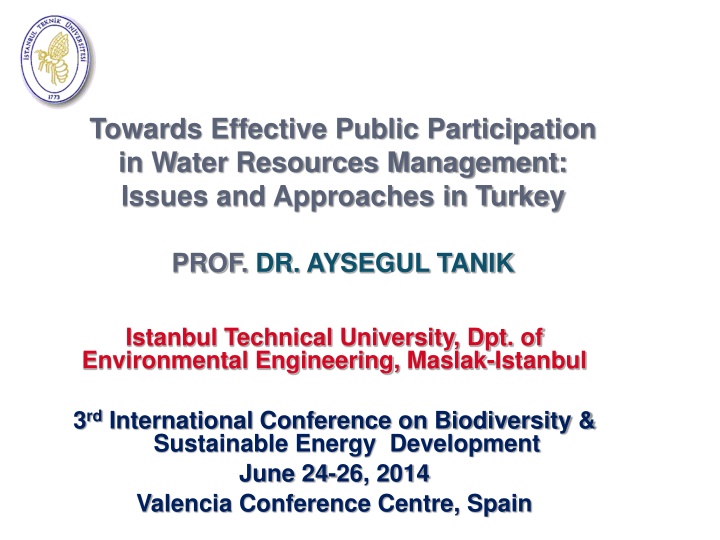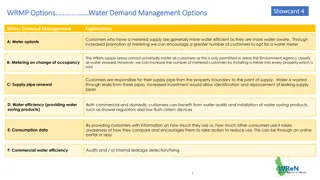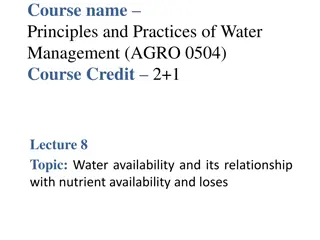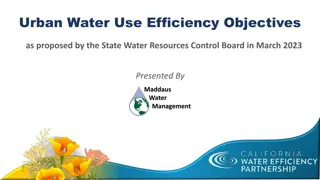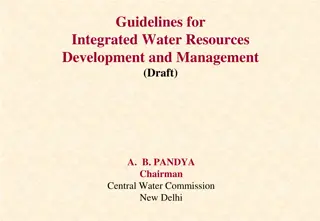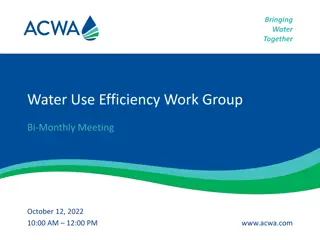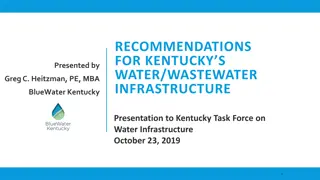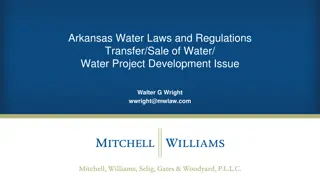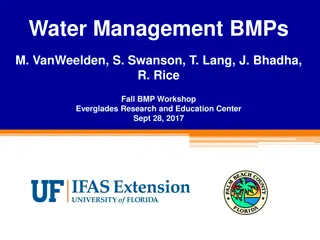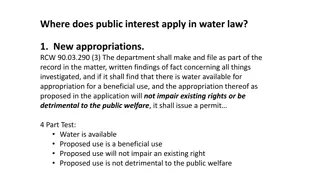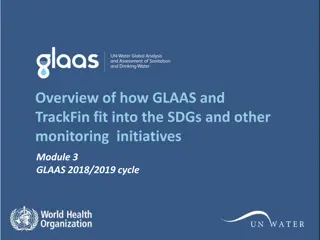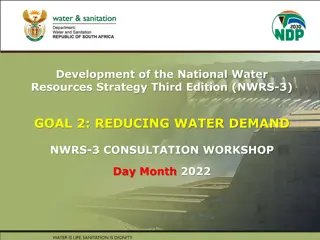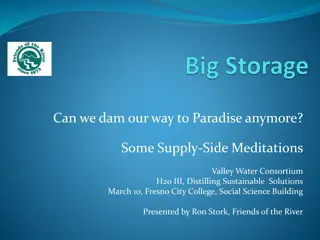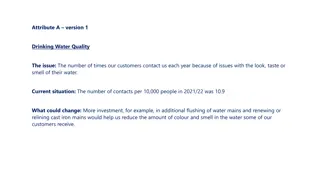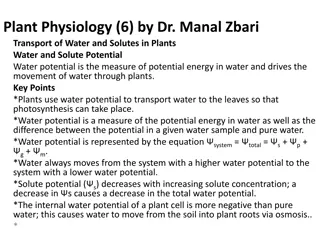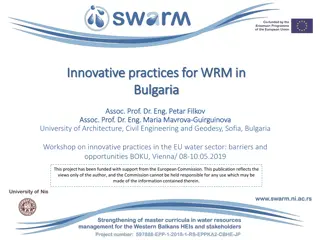Effective Public Participation in Water Management Issues
Sustainable water use, historical developments, and integrated approaches in water resources management, with a focus on Turkey and the European Union Water Framework Directive. Key topics include rapid population increase, urbanization, climate change, and stakeholder engagement.
Download Presentation

Please find below an Image/Link to download the presentation.
The content on the website is provided AS IS for your information and personal use only. It may not be sold, licensed, or shared on other websites without obtaining consent from the author.If you encounter any issues during the download, it is possible that the publisher has removed the file from their server.
You are allowed to download the files provided on this website for personal or commercial use, subject to the condition that they are used lawfully. All files are the property of their respective owners.
The content on the website is provided AS IS for your information and personal use only. It may not be sold, licensed, or shared on other websites without obtaining consent from the author.
E N D
Presentation Transcript
Towards Effective Public Participation in Water Resources Management: Issues and Approaches in Turkey PROF. DR. AYSEGUL TANIK Istanbul Technical University, Dpt. of Environmental Engineering, Maslak-Istanbul 3rdInternational Conference on Biodiversity & Sustainable Energy Development June 24-26, 2014 Valencia Conference Centre, Spain
SUSTAINABLE WATER USE Rapid Population Increase Urbanization Increase in Water Demand Water Pollution Drought/Flooding Desertification Deforestation Pollution Sources (point, diffuse, natural, etc.) Degradation of Ecosystems Climate Change Encouraging use of available water and land resources the sustainable Rehabilitation and prevention of further deterioration of water and water related ecosystems
HISTORY Till 1980 s After 1980 s Focusing on water supply Integration Finding solutions in large scale to numerous problems Quantity of Water was the priority issue Planning with limited scale for specific purposes International Principles New Concepts Sustainability Participation of Stakeholders Integrated Understanding and Transition to management Producing single solutions to specific/unit problems
Sustainability & Integration Meeting the current targets and needs, without interrupting the demand and needs of future generations, in an integrated manner Integration of Environmental Media (Air, Water, Soil, Surface Waters, Groundwater, Land-Use, Erosion, Wetlands, Coastal Zones, etc. and interaction among them) Integration of environmental factors with social, economic, administrative and legal components (SUSTAINABILITY) Integration of various disciplines Integration of actors (COORDINATION) Integration of Financial Sources Integration of Management Tools (Decision- support Systems, data bases, models, GIS, expert systems) Climate change and potential risks
European Union Water Framework Directive Integrated River Basin Management Approach been assimilated as a tool in the application of the Directive. has WHAT IS EXPECTED? I. Determining the watershed regions II. Forming expert organizations III. Performing watershed plans
Integrated River Basin Management Approach Determining the watershed regions Combining one or more river basins II. Forming Expert Organizations At watershed basis (for each of the watershed region) At National scale, If exists at international basis for transboundary waters. Method; By an already existing expert organization and through revising its duties, By means of a commission design that includes the related ministries, By defining a new structure that is independent from the existing organization and institutions, III. Preparation of River Basin Management Plans (RBMP)
Fundamental Steps of RBMPs Important pressures and impacts of human-induced activities; Determining and mapping of Protection Areas; i. ii. iii. Mapping of monitoring network; iv. Listing the environmental goals; v. Economical Analyses; vi. Forming the Preventive Measures Program; vii. Preparing detailed plans that covers an abstract; viii. Informing public and summarizing the preventive measures; ix. Listing the authorities responsible from watershed management; x. Determining the communication points and related communication procedures formed to gain information and evaluations from public. xi. Characterization of the River Basin;
Informing Public, Summary of Consultation Results Forming the Participation Plan. (All the state offices and organizations, private sector, chambers of various disciplines, chamber of industry, active NGOs at the watershed scale need to be encouraged for participation) Preparing the criteria for consulting and public informing. Reporting, Presenting and Discussion of the results.
What is the Public Participation? Public participation is a planned effort to involve citizens in the decision-making process and to present and resolve citizen conflict through mutual two-way communications. Planning of Public Participation Process Identification of the objectives Identification of the selected actors Choice of the methods of the public participation Preparation of the implementing plan
Pyramid of the members of the public participation process Decision- making bodies Agencies responsible for the implementation of the pp plan Competent professionals on the examined topic NGOs Stakeholders, layers
Orbits of involvement Unsurprised apathetics Observers Commenters Technical reviewers Active participants Co-decisionmakers
Why public participation? to comply with the Directive and to achieve environmental goals and other benefits Key potential benefits: increasing public awareness of environmental issues making use of knowledge, experience and initiatives of the different stakeholders public acceptance, commitment and support with regard to decision taking processes; more transparent and more creative decision making; less litigation, misunderstandings, fewer delays and more effective implementation; social learning and experience if participation results in constructive dialogue with all relevant parties involved then the various publics, government and experts can learn from each others water awareness .
Disadvantages of the Public Participation Costs include the potential for confusion of the issues many new perspectives may be introduced it is possible to receive erroneous information include uncertainty of the results of the process Main Objectives of the Public Participation Establish and maintain the legitimacy of the agency Establish and maintain the legitimacy of the project Establish and maintain the legitimacy of all major assumptions and earlier decisions Get to know all the potentially affected interests Identify problems Generate solutions Articulate and clarify the key issues To develop informal acceptance of options
What is PP NOT about? (source: Public Participation Guidance) everybody joining: be selective with actors, they should reflect the right interest everybody deciding: responsibilities are, and for whom losing control: do organise strategically consensus at all expenses: be prepared that the outcome of public participation will be compromise between the wishes of several actors and that extend of the process is often limited. make clear what the it well, clear and
Models of national PP processes General requirements to the models To allow active interaction between the proponent and participants Are expected to be used in any number of stages of a participatory process Need to be sufficiently flexible to accommodate a range of possibilities
4 models of Public Participation Social Learning Consent/ Consensus Commentary Joint Planning Proponent- centred Intermediary - centred Participant - centred
Relationships in the Commentary model Stakeholder B Stakeholder C Stakeholder A Stakeholder D Proponent
Relationships in the Social Learning Model Individual B Individual C Individual A Individual D Intermediary Proponent
The Joint Planning Model Intermediary Proponent Stakeholder A Stakeholder D Stakeholder B Stakeholder C
Relationships in the Consent / Consensus Model Proponent Stakeholder A Stakeholder D Mediator Stakeholder B Stakeholder C
PP Activities Cleaning/ rehabilitation days Volunteering monitoring groups Site visits/ surveys Meetings Training programs (schools, city groups, local org.) Various activities heading focal points Public surveys Media/ internet
Activities for participation in EU Member State Countries EU countries has started application of RBMPs Information on the status of applications covering years 2009-2015 are given on the website of European Commission.
UK & Wales Public Participation is realized through media, internet, printed materials invitations sent to various related groups. Workshops and panels are organized at the basins with various related groups. Face-to-face contact is preferred; however, messages are also sent via internet.
UK & Wales Stakeholders are, water companies, farmers, Harbour corporations, fishermen, Industries, protection associations, Local and local planning authorities, NGOs, Consumer groups and general public.
UK & Wales Recently, some plan changes have occurred as a result of public consultation in some basins. At the web page of Scotland, a summary file is present that covers the anxieties of public. During the consultation period, researches on these concerns increased. Various amendments will take place in the plans as a result of new measurements and by the addition of new information. Scotland has also initiated some consultancy groups under Water Environment Services for better RBMPs.
Denmark An agreement is signed at April 2010 at the Parliament named as Green Growth" after the development of RBMPs. www.vandognatur.dk, a special website for informing public on water plans is formed. Consultation with public on the draft plans are separated into two steps; Initially; municipalities, regions and public offices are being consulted on the plans. Afterwards, public consultation started.
Denmark Written notices were delivered by individuals, commercial sites, environmental organizations, agricultural consultancy centres, and public enterprices. The initial meetings are realized by the municipalities, regions and public offices. Through the public consultation, more than 4200 feedback is received from public for the water and nature plans. During the additional period, 1700 additional survey results were achieved.
Denmark In the final plans, one can easily recognize the effects of public participation, the related amendments realized are observed. comments and corresponding The participations are summarized in the web site of Nature Agency (www.naturstyrelsen.dk). Importance of public participation is clearly defined; as the amendments done on the plans (RBMPs) relied on realistic measurements. Consultations were mainly focusing on, discharges, conditions of water masses, recommended activities
Denmark All the feedback received from public are considered and reflected in the plans. No information is present on whether such consultation periods will continue or not in the future; however, a water and nature association is formed consisting of members from Municipalities, Nature protection agencies, NGOs, Regional authorities.
STATUS OF TURKEY ISSUES & APPROACHES IN RBMPs
Main Challenges of Water Sector in Turkey 1- WATER QUANTITY PROBLEMS 2- WATER QUALITY PROBLEMS 3- IRRIGATION MANAGEMENT 4- AGRICULTURAL PRACTICES 5-LACK MANAGEMENT AND LAND USE PLANNING OF RELATIONSHIP BETWEEN WATER RESOURCES 6- DEFICIENCES OF MONITORING SYSTEM AND INCOMPLETE DATA 7- LEGAL ISSUES 8- ORGANIZATIONAL STRUCTURE 9- CHALLENGE OF TRANSPOSING AND IMPLEMENTING ALL ELEMENTS OF THE EU WFD
Main Challenges of Water Sector in Turkey Water issues that Turkey faces today are largely derived due to lack of good and efficient governance. Organizational structure for water resources management is highly centralized. Stakeholder participation in decision-making process is at a low level. The lack of a comprehensive water law, fragmentation of the institutional framework, complexity of coordination mechanisms are the other major challenges in the Turkish water sector.
Determination of the Actors and the Management Purposes Identification of Watershed system Information System Watershed Improvement of monitoring network Data reliability Forming databases Data analyses Online data transfer Decision Support System Watershed Modeling Scenarios Evaluation of decisions taken and their impact Decision Models Determination of Management Decisions Application and Monitoring Querrying actors, purposes of management and the proposed Management Plan
Improvement of Monitoring Network GENERAL DIRECTORATE OF STATE WATER WORKS Sampling stations are lacking Measurement frequencies are different. Measurement terms are different. Stations are at various locations. Data obtained are stored in different organizations. 1310 stations conduct seasonal analyses (4 times a year; 59% for drinking purposes and 41% for general use) Additionally heavy metal (6 times) and biological analyses in drinking water 35 parameters are analyzed in groundwater's (2 times a year) Former General Directorate of Electrical Power Resources Survey and Development Administration General Directorate of Renewable Energy 140 STATIONS, 20 parameters NATIONAL WATER DATABASE (under preparation) UNIVERSITIES T B TAK
Public Institutions related with Water Management Ministry of Forestry and Water Affairs General Directorate of Water Management Various bureaucratic institutions are responsible from the management of watersheds General Directorate of State Water Works (DS ) General Directorate of Meteorological Works (DM ) General Dir. of Forestation and Erosion Control Ministry of Environment and Urbanization General Dir. of Environmental Management General Dir. of EIA and Planning Bank of Provinces Facing serious problems during the management and planning of resources organization bear self specific approaches Ministry of Energy and Natural Resources General Directorate of Renewable Energy Resources as each Ministry of Food, Agriculture and Livestock Ministry of Health Ministry of Interior Works Ministry of Culture and Tourism Ministry of Development Water and Sewage Administrations in Greater Municipalities Special Provincial Administration Fund
Including STAKEHOLDERS in the water management Improvement coordination and co-operation process among the institutions responsible for water resources, environmental management, agriculture, etc. Public Participation and Awareness ENACTING THE NATIONAL WATER FRAMEWORK ACT Identification of River Basin Authorities and Capacity Building
TRANSPOSITION OF THE EU WFD IN NATIONAL LEGISLATION TRANSBOUNDARY WATERS ENACTING THE NATIONAL WATER FRAMEWORK ACT Turkey will be obliged to ratify Aarhus, Espoo and Helsinki Conventions that the EU is a party.
Recent Improvements At 09.04.2012 National Basin Management Strategy (Draft) is pre-published to take the opinions of the related groups. It acts as an initial guide on how the public participation be managed in the water and basin related affairs. All the stakeholders are referred in the document. The regulation on Protection of Basins and Preparation of their Management Plans is put into force on17.10.2012 . Item 5 of this regulation emphasises on Participatory Management Approach . Item 6 mentions that during the preparation of the RBMPs active participation of all related institutions will be maintained and comments will be taken from all the related parties. It also bears some points for the encouragement of effective public participation during the preparation, reviewing and updating stages of RBMPs. Moreover, it underlines the importance of informing public .
Recent Improvements The Commission, its duties, working methodology and principles is put into force on 18.06.2013. statement on Establishing Basin Management This statement defines the duties and responsibilities of Basin Steering Committee as well Management Commissions (representatives directorates of the related ministries, local authorities, local universities, NGOs, chambers of industry and commerce, farmers, etc.). lists the members of of provincial Basin the Information is provided by this statement on the meetings to be realized and the outline of these meetings, working methodology and applications. Thus; the publication of these legislative notices act as initial movements towards the realization of public in the preparation of RBMPs.
Recent Improvements Coordinator governorship of the coordinator provinces will be the head of the Basin Management Commissions. provinces of the 25 basins are stated. The These commissions will take common decisions by majority votes. is observed that all the recent consideration of holistic management participation from all the water and basin related groups. It developments approach , take into public During the harmonization stage with EU, these recent legislative improvements need to be realized to comply with EU Water Framework Directive. Participation of NGOs are of utmost important at this stage. In the recent years, they have taken a step further by realizing programs and applications on the rehabilitation of spoilt areas, deforestation, soil protection and protection of biological diversity.
THANKS FOR YOUR ATTENTION
